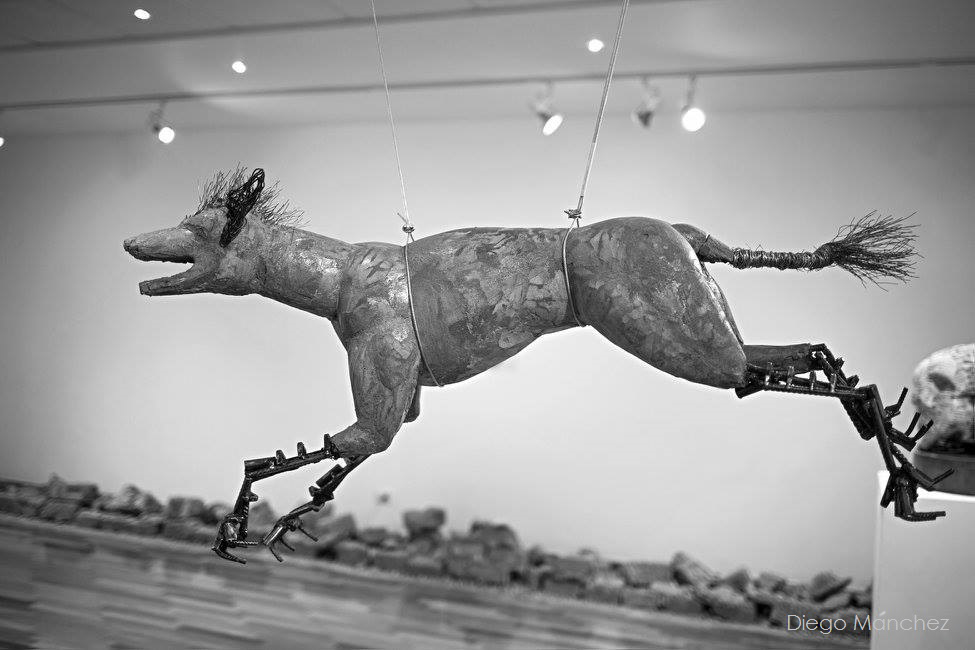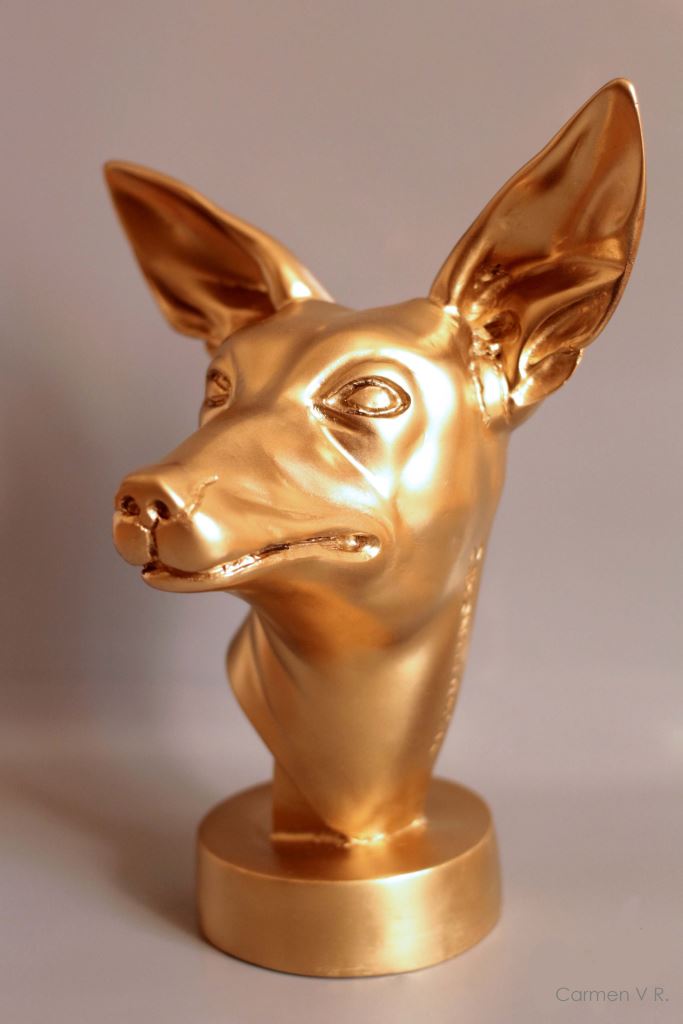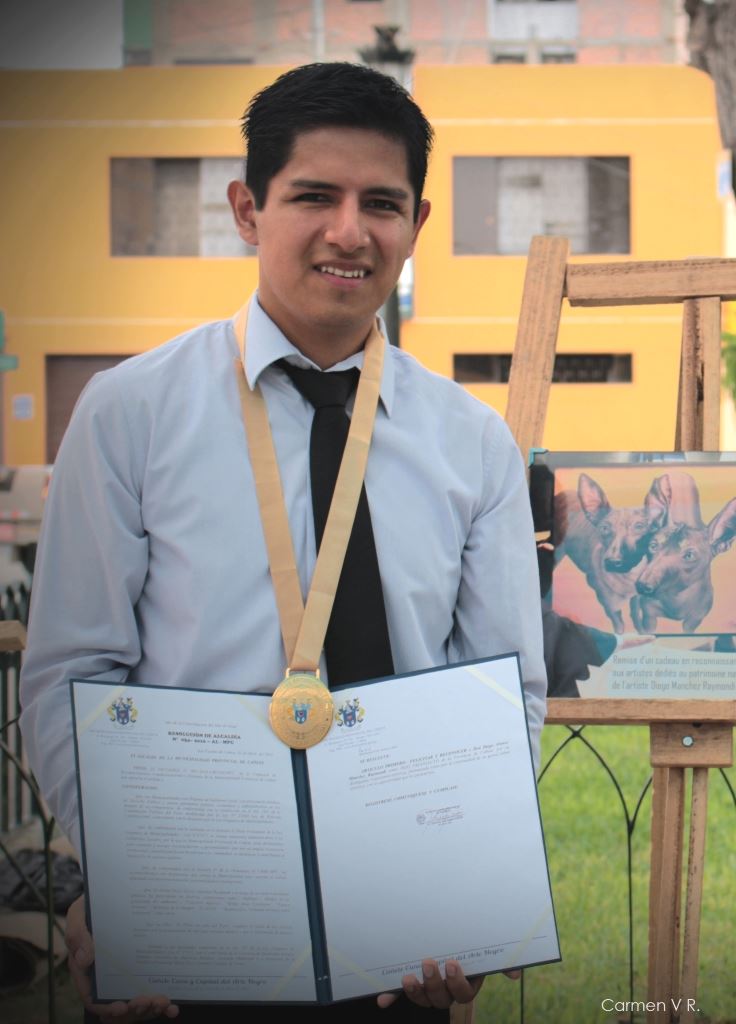Little hairless Peruvian dog
Little Chinese dog
hungry naked little dog
don’t eat my hands yet because I want to stroke you.
Negro Agüero
-


Diego Mánchez and his sculpture Técnica, forged from metal, actual size: 120 x 55 cm, approximate weight: 15 kg; Bellas Artes exhibition hall, Lima (Peru)
-


“Viringo Once Segundos en el Tiempo” project, sculptural installation, technique: concrete and metals, actual size: 55 x 75 cm; hall of the Escuela de Bellas Artes, Lima (Peru)
-


Peruvian hairless dog in concrete and metal
-


Peruvian hairless dog in concrete and metal
-


“Viringo Once Segundos en el Tiempo” project; ICPNA exhibition hall – Lima, February 2015
-


Sculpture of Peruvian hairless dog
-


7 Sculpture of Peruvian hairless dog, Kunstwollen exhibition, “Voluntad Artística sobre la Materia”; San Isidro cultural centre exhibition hall, Lima (Peru), September 2015
-


Diego Mánchez and his metal sculpture; Bellas Artes exhibition hall, December 2014
-


Portrait, bust in tribute to the “hairless dog”, fibreglass sculpture, gold finish, measurements: 24 x 14 cm
-


Sculpture of hairless dog made of fibreglass, dimensions: 30 x 14 cm; currently part of the Klub Chovatelů Naháčů, Prague, Czech Republic, April 2016
-


Artist Diego Mánchez at the ceremony held in recognition of his artistic career, Cañete – Lima, April 2016
-


Study for drawing of the “Peruvian hairless dog”
-


“Viringo - Perro sin Pelo del Perú” painting done in 2014, 36 x 25 cm, currently part of the collection of the Peruvian Embassy in the Czech Republic, April 2016
-


Painting by the artist Diego Mánchez at the headquarters of the United Nations Educational, Scientific and Cultural Organisation (UNESCO) in Paris, France, November 2015.
-


“Guardián viringo” sculpture at the screening of the film entitled “LE CHIEN NU DU PEROU” by Pedro Santiago Allemant, at the headquarters of the Fédération Cynologique Internationale (FCI) in Thuin, Belgium, November 2015
This is a legendary creature. Its spirit guides the dead as they travel towards
the hereafter. They were buried together with the most important men of the estates
of Northern Peru. Their image has been handed down to us in the art of the ancient
Peruvians. We are talking about the Peruvian Hairless Dog, a dog breed known all
over the world for its beauty, history and even its curative properties.
The tradition of recognising the Peruvian Hairless Dog (which is also known as the
“perro viringo”, “vitilingo”, “perro chino” [Chinese Dog],
“perro chimú”, “perro
calato” [Naked Dog], “perro de Sechura” and by many other names) has
grown and become
better-known over the last few years. This is the background to the appearance of
the artistic work of a young sculptor, and indeed this work is now spanning the
globe.
Diego Mánchez Raymondi (Lima, Cañete, 1988) is a graduate of the Escuela Nacional
Autónoma de Bellas Artes, specialising in sculpture, and his interest in the hairless
dog started to grow just as he was reaching the end of his studies: “When I was
working on the artistic installation in tribute to the Peruvian hairless dog project,
I based what I was doing on the historic image of this animal, considering its relevance
to the Andean view of the world found in ancient Peru and as a source of social
beliefs which were manifested through the artistic representations of the Chavin,
Cupisnique, Salinar and Chimu cultures as well as Moche ceramics”.
His main subject is the hairless dog in historic memory, for which he draws on his
own life and experience. Mánchez has a special relationship of his own with the
Peruvian hairless dog because, when he was fifteen, he was given a small “viringo”
which, unfortunately, died a year later. Even so, his love for his dog managed to
cross the borders of memory and has now been turned into art. In 2014, the artist
created the sculpture installation entitled Viringo, Once Segundos en el Tiempo,
which consists of portraying the Peruvian dog in sculptures. “One scene”, comments
the artist, “consisted of creating a Peruvian dog which could cheat death. In a
locked room with light and shade installations, the dog is reborn out of the earth
and flies through the air as it comes back to life”, thus giving expression to a
surrealistic vision.
Diego Mánchez has created a varied body of work interweaving painting, sculpture
and drawing, using various different materials and so, thanks to his ingenuity and
skill, we are able to enjoy works of art inspired by the Peruvian Hairless Dog employing
media such as oil painting, watercolours, sculptures in concrete, metal, fibreglass
and others. In addition to this, his body of work includes more than eleven sculptures
of Peruvian hairless dog in motion, using both sculptural assembly techniques and
concrete and metals as the main materials, and each piece can weigh up to around
25 kilos. But why choose cement as the raw material for the sculpture given that
its hardness and rigidity are in contrast to the gentleness of the Peruvian hairless
dog? “I wanted to move away a bit from materials such as fibreglass / resin and
the realistic figure” replies Diego Mánchez. “I tried to create my own line as an
artist and to explore rigid sculptural materials, so as I was using an element such
as concrete I put it together with an urban subject matter, in the way I did years
ago with four pieces showing hairless dogs made of concrete and which were soiling
the Peruvian flag. Soiling our country’s flag was a political critique, which is
why I identified with it”, said the sculptor.
At the moment, behind each of Diego Mánchez’s paintings or sculptures there is affection
for his new dog Samin, a charming hairless dog; but also an exhaustive study of
the physiognomy of the hairless dog, including the way they move when they walk,
run or jump; their musculature, dimensions, shapes, lines, etc., as well as historical
research: “I’m really interested in the Peruvian hairless dog and I’ll carry on
investigating it and getting to know it better”. Mánchez acknowledges that this
is the only way of both promoting the image of the hairless dog and preserving it
in its home country. This is a dog which is considered to be living cultural heritage,
an age-old breed which needs to be protected: “One of the conclusions drawn from
my research project at the Escuela de Bellas Artes is that we have to promote the
protection, defence and care of the Peruvian Hairless Dog, and of all animals, along
with biodiversity and endangered species”, and this is a commitment which is now
being fulfilled through art.
N.B. One piece by the artist Diego Mánchez is at the United Nations Educational,
Scientific and Cultural Organisation (UNESCO) in France and, in addition to this,
his sculpture of the Peruvian hairless dog, “Guardián viringo”, is part of the private
collection of the Fédération Cynoloqique Internationale (FCI) museum in Belgium.
Another of his sculptures is at the Klub Chovatelů Naháčů in the Czech Republic.
Diana Gonzales Obando